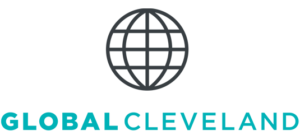Global Employer Summit: Realizing the Untapped Potential of Global Talent in NEO
Expert Strategies + Global Talent = A World-Class Cleveland
May 31, 2017
Dany Bahar, PhD Brookings Institution, Harvard University Center for Development
After a brief introduction by Global Cleveland President Joe Cimperman, Dany Bahar, PhD, of the Brookings Institution and the Harvard University Center for Development, told the crowd he was there “to wake you up.” He told the group that, contrary to current rhetoric, immigration plays a critical role in the global economy. His research focuses on how immigrants diffuse knowledge around the globe and create jobs in their wake.
Migrants represent 15% of the US population, yet make up more than 27% of entrepreneurs in the United States. Bahar used the example of Siracha sauce, an Asian hot sauce that has become ubiquitous throughout the US. The US manufacturer, Huy Fong, was founded in 1980 by David Tran, who named the company after the freighter that carried him and 3,000 other refugees from Vietnam to California in 1978. Today, Huy Fong has nearly 200 employees and its annual sales exceed $60 million per year. Bahar went on to explain that new businesses (those less than 5 years old) have created ~1.5 million jobs per year for the past several decades.
What about the effect on local wages? That depends, he said, on whether the immigrants are complements or substitutes for the native or existing workforce. A 2011 study found that migrants tend to compete with migrants. And a study from 2015 showed that unskilled natives respond to increased immigration via upward skills mobility—focusing on work that makes better use of their command of English, or moving to other less manual jobs.
Bahar also noted that migrants consume just as natives, thus adding to aggregate demand and job creation on local economies. And while many illegal immigrants do pay taxes, they do not claim the benefits. He noted a recent report that shows the average fiscal burden of each migrant is about $1,600. But second and third generation migrants create a net positive fiscal contribution of $1,700 and $1,300, respectively.
Migrants bring diversity and diversity builds output, Bahar said. A 2016 study showed that increasing birthplace diversity of skilled immigrants by 1 percentage point raises long-run output by about 2%. For US firms struggling to export and invest in foreign countries, migrants can reduce the cost of doing business by providing a bridge between the 2 countries. For example, he said, a recent study showed that US states that randomly received more Vietnamese refugees in the late 1970s are larger exporters of goods and services to Vietnam today. More importantly, the study showed this is applicable to all countries and particularly for goods that are differentiated, and is applicable to investment.
Migration also plays a critical role in the international diffusion of knowledge, Bahar said, which is good, since knowledge is difficult not only to transfer, but also to acquire. “If I had a toothache, I could read all the information on the Internet and all the books and look in my mouth, but would I have the knowledge to fix it?” Bahar asked the crowd. There is knowledge in books, then there is knowledge that cannot be put on paper. “You want an airplane pilot with experience in the cockpit flying the plane,” he said, “not someone who got A’s in bookwork only.”
Crediting the works of Michael Polanyi and Kenneth Arrow, Bahar explained that productive knowledge has a large tacit component—nuances that can only be learned by doing, and that channels for transmission of tacit knowledge are limited to human interaction. So the spread of tacit knowledge relies on human minds, not written words, and migrants provide this increased level of human interaction. In turn, those interactions spur innovations on a local level and that expertise will spread as individuals move. In support, he cited examples from patent citations, which are predominantly local; the challenge multinationals have transferring knowledge with subsidiaries around the globe; the import-export growth of wine and rugby jerseys between South Africa and France; and the growth of exports from Germany after refugees from the Balkan war returned to their former Yugoslavian countries.
There is vast evidence on the positive role migrants play in the economy, Bahar said. “In the era of productivity slowdown, knowledge diffusion is the biggest challenge our economies face. It is far easier to move brains than knowledge.”
Regarding policy, Bahar noted that illegal migrants and refugees may have less to offer because of the uncertainty of their situation, which prevents them from investing. Conversely, he acknowledged the risk employers take when investing in migrants because working migrants have a better chance to go back and contribute to the development of their home countries and in turn make strong economic links with the US.
He concluded by asking, if temporary migration is good—the employer gets the benefit of the migrant’s work product while employed, then why don’t more firms do it? The answer, which would be echoed throughout the day, is uncertainty.
–Reporting by Janice T. Radak for Global Cleveland

